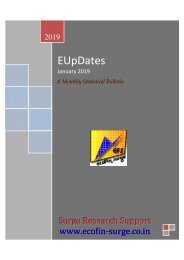EUpDates—A Monthly Statistical Bulletin of Economic Indicators
The Monthly e-Bulletin for Economic/Financial Market Indicators—over 30 tables and charts and a review of the economy, helps you and/or your students to stay informed about the Indian and global economy and financial markets.
The Monthly e-Bulletin for Economic/Financial Market Indicators—over 30 tables and charts and a review of the economy, helps you and/or your students to stay informed about the Indian and global economy and financial markets.
You also want an ePaper? Increase the reach of your titles
YUMPU automatically turns print PDFs into web optimized ePapers that Google loves.
A Quick Review of the Economy
GLOBAL ECONOMIC GROWTH is projected to fall to -3% in 2020 by the IMF in the April World
Economic Outlook, under the assumption that the pandemic and required containment peaks in the
second quarter for most countries in the world, and recedes in the second half of this year. A lot
depends on the epidemiology of the virus, the effectiveness of containment measures, and the
development of therapeutics and vaccines, all of which are hard to predict. Countries reliant on tourism,
travel, hospitality, and entertainment for their growth are experiencing particularly large disruptions.
Emerging market and developing economies face additional challenges with unprecedented reversals in
capital flows as global risk appetite wanes, and currency pressures, while coping with weaker health
systems, and more limited fiscal space to provide support. Moreover, several economies entered this
crisis in a vulnerable state with sluggish growth and high debt levels. For the first time since the Great
Depression both advanced economies and EMDEs are in recession. For this year, growth in AEs is
projected at -6.1%. EMDEs with normal growth levels well above AEs are also projected to have
negative growth rates of -1.0% in 2020. The OECD composite leading indicator posted its lowest
reading since the 2008 recession, coming in at 98.8 in March in amplitude-adjusted terms. The J. P.
Morgan Global PMI Composite Output Index fell to a 133-month low of 39.4 in March, as the global
service sector saw business activity, new business and new export business all contract at the steepest
rates in the survey history. New manufacturing order intakes contracted at the steepest pace since
early-2009, with new export orders falling at the quickest pace in almost 11 years. Output contracted
across all six of the sub-sectors covered by the survey.
UNITED STATES growth is projected by IMF to fall by 5.9% in 2020. Industrial production fell 5.4% in
March, as few parts of the U.S. economy have avoided the impact of COVID-19. Retail sales plunged
8.7% in March as store closures and stay-at-home orders impacted a growing number of consumers
through the month. The producer price index slipped 0.2% in March but the disinflationary pressures
will intensify over the next couple of months. The incredibly high level of initial claims for
unemployment insurance benefits continues to hurt, but at least claims appear to be flattening. The
federal government has incurred a cumulative budget deficit of $743.6 billion in the first six months of
fiscal 2020, compared with $691.2 billion over the same period last fiscal year. The four-week moving
average in our U.S. policy uncertainty index increased from 166.2 to 174.2 in the week ended April 10.
EURO AREA growth is projected by IMF to contract by 7.5% in 2020, with growth n Germany falling
7%, in France 7.2%, in Italy 9.1% and in Spain by 8%. Industrial production fell by 0.1% m/m in
February after surging by 2.3% in January, beating the consensus for a sharper decline. Inflation
plunged to 0.7% y/y in March from 1.2% in February, its joint-lowest since November 2016. A report
by McKinsey and Co. showed that as many as 59 million European jobs could be at risk due to the
coronavirus, about 27% of the continent’s workforce between the European Union and the United
Kingdom. With economic activity in many sectors having ground to a near standstill, many businesses
are struggling to uphold their financial obligations. Rifts between the nations have opened up during
recent negotiations over an economic rescue package, which pitted richer countries against poorer ones
— just like during the debt crisis at the beginning of the previous decade. the ECB currently has three
main tools at its disposal. The first is the European Investment Bank guarantee, which has €25 billion
available. The second is the European instrument for temporary Support to mitigate Unemployment
Risks in an Emergency (SURE) program, which will provide lending of €100 billion to avoid job losses.
The third is the European Stability Mechanism (ESM), which provides low-conditionality precautionary
credit lines and already has €240 billion available, which can be increased up to €400 billion. Following
the agreement the Eurogroup reached, governments will be able to use the ESM to access the equivalent
of 2% of their GDP. UNITED KINGDOM growth is projected by IMF to contract by 6.5% in 2020. UK
joblessness rose to 4% in the February quarter from 3.8% in the November stanza, worse than
expectations. The economy could shrink by 35% this spring and unemployment soar by more than 2
million due to the coronavirus crisis, the the Office for Budget Responsibility said. GDP could plunge by
13% for 2020 as a whole according to OBR estimates, while public borrowing could rise to around
£273bn, or 14% of GDP.
JAPAN’s growth is projected by IMF to contract by 5.2% in 2020. Business sentiment among large
manufacturers fell into negative territory in March for the first time in seven years. The key index,
measuring confidence among companies such as automobile and electronics makers, fell to minus 8
from zero in December. Among the measures taken in March included a pledge for the BOJ to spend up
to 2 trillion yen ($18.56 billion) by September to increase its holdings of corporate bonds and CP.
China’s is estimated to maintain positive growth of 1.2% in 2020, a reduction from 6% growth in the
IMF’s January forecast. China’s GDP shrank 6.8% in the first quarter from a year earlier, missing the
consensus forecast of a 6% drop and logging the worst performance since at least 1992 when official
releases of quarterly GDP started. Factory output fell 1.1% in March, retail sales slid 15.8% and
investment decreased 16.1% in the first three months of the year. EMDEs face a health crisis, severe
external demand shock, dramatic tightening in global financial conditions, and a plunge in commodity
prices, which will have a severe impact on economic activity in commodity exporters according to the
April WEO.
The COVID-19 pandemic has created severe disruption in the global financial system, with many EMDEs
facing liquidity shortages. Countries have taken fiscal measures and central banks together injected a
whopping US$14 trillion as part of their efforts to mitigate the challenges posed by the novel
coronavirus pandemic, the IMF said and has called for central bank liquidity swap lines to be extended
to more emerging market countries, which face a double problem of locked-down activity and
tightening financial conditions caused by a massive outflow of funds to save-haven assets such as U.S.
Treasuries. The fund has doubled access levels to emergency facilities, expanded the use of
precautionary lines, established a new short-term liquidity line andis considering other options to help
countries meet their financing needs.
E-UpDates April 2020
2
Surge Research Support










